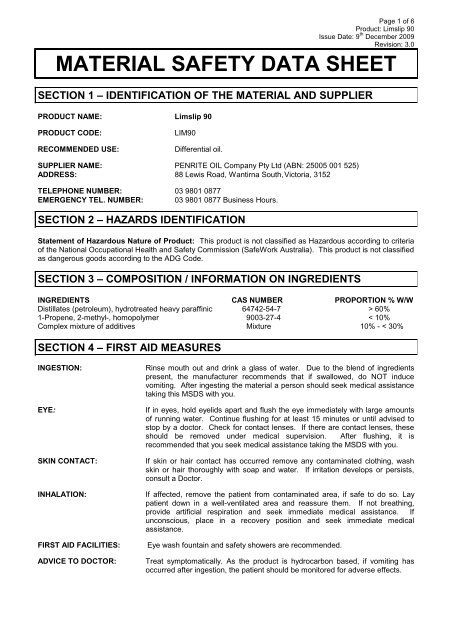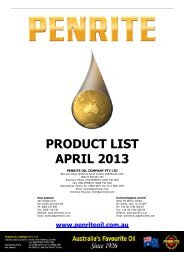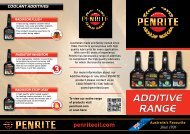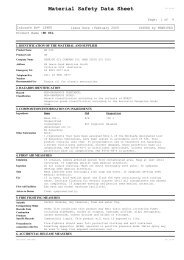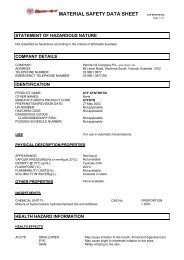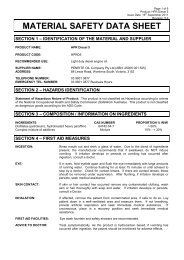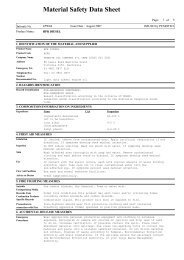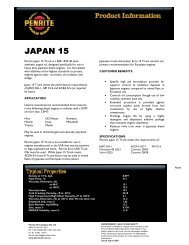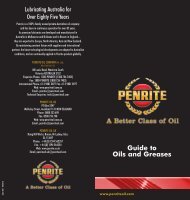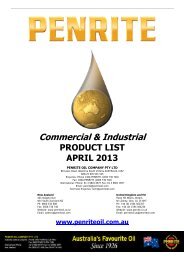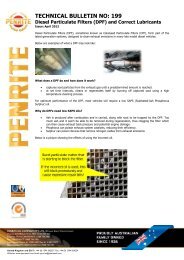material safety data sheet - Penrite
material safety data sheet - Penrite
material safety data sheet - Penrite
You also want an ePaper? Increase the reach of your titles
YUMPU automatically turns print PDFs into web optimized ePapers that Google loves.
Page 1 of 6<br />
Product: Limslip 90<br />
Issue Date: 9 th December 2009<br />
Revision: 3.0<br />
MATERIAL SAFETY DATA SHEET<br />
SECTION 1 – IDENTIFICATION OF THE MATERIAL AND SUPPLIER<br />
PRODUCT NAME: Limslip 90<br />
PRODUCT CODE:<br />
RECOMMENDED USE:<br />
LIM90<br />
Differential oil.<br />
SUPPLIER NAME: PENRITE OIL Company Pty Ltd (ABN: 25005 001 525)<br />
ADDRESS: 88 Lewis Road, Wantirna South, Victoria, 3152<br />
TELEPHONE NUMBER: 03 9801 0877<br />
EMERGENCY TEL. NUMBER: 03 9801 0877 Business Hours.<br />
SECTION 2 – HAZARDS IDENTIFICATION<br />
Statement of Hazardous Nature of Product: This product is not classified as Hazardous according to criteria<br />
of the National Occupational Health and Safety Commission (SafeWork Australia). This product is not classified<br />
as dangerous goods according to the ADG Code.<br />
SECTION 3 – COMPOSITION / INFORMATION ON INGREDIENTS<br />
INGREDIENTS CAS NUMBER PROPORTION % W/W<br />
Distillates (petroleum), hydrotreated heavy paraffinic 64742-54-7 > 60%<br />
1-Propene, 2-methyl-, homopolymer 9003-27-4 < 10%<br />
Complex mixture of additives Mixture 10% - < 30%<br />
SECTION 4 – FIRST AID MEASURES<br />
INGESTION:<br />
EYE:<br />
SKIN CONTACT:<br />
INHALATION:<br />
FIRST AID FACILITIES:<br />
ADVICE TO DOCTOR:<br />
Rinse mouth out and drink a glass of water. Due to the blend of ingredients<br />
present, the manufacturer recommends that if swallowed, do NOT induce<br />
vomiting. After ingesting the <strong>material</strong> a person should seek medical assistance<br />
taking this MSDS with you.<br />
If in eyes, hold eyelids apart and flush the eye immediately with large amounts<br />
of running water. Continue flushing for at least 15 minutes or until advised to<br />
stop by a doctor. Check for contact lenses. If there are contact lenses, these<br />
should be removed under medical supervision. After flushing, it is<br />
recommended that you seek medical assistance taking the MSDS with you.<br />
If skin or hair contact has occurred remove any contaminated clothing, wash<br />
skin or hair thoroughly with soap and water. If irritation develops or persists,<br />
consult a Doctor.<br />
If affected, remove the patient from contaminated area, if safe to do so. Lay<br />
patient down in a well-ventilated area and reassure them. If not breathing,<br />
provide artificial respiration and seek immediate medical assistance. If<br />
unconscious, place in a recovery position and seek immediate medical<br />
assistance.<br />
Eye wash fountain and <strong>safety</strong> showers are recommended.<br />
Treat symptomatically. As the product is hydrocarbon based, if vomiting has<br />
occurred after ingestion, the patient should be monitored for adverse effects.
MATERIAL SAFETY DATA SHEET<br />
SECTION 5 – FIRE FIGHTING MEASURES<br />
Page 2 of 6<br />
Product: Limslip 90<br />
FIRE:<br />
EXPLOSION:<br />
FIRE EXTINGUISHING<br />
MEDIA:<br />
COMBUSTION<br />
HAZARDS:<br />
PROTECTIVE<br />
EQUIPMENT:<br />
This product is not flammable under conditions of use. Is a combustible liquid<br />
that will burn if preheated. Keep storage tanks, pipelines, fire exposed surfaces,<br />
etc. cool with water spray.<br />
No information to indicate that the product is an explosion hazard. Extinguish all<br />
sources of flame or spark. Closed containers may explode when exposed to<br />
extreme heat. Do not cut, weld, drill or pressurise empty metal containers.<br />
Use extinguishing media appropriate for surrounding fire. Use carbon dioxide,<br />
foam, dry chemical or water fog. Spray down fumes resulting from fire. Avoid<br />
using full water jet directed at residual <strong>material</strong> that may be burning. Water may<br />
cause splattering. Product will float on water.<br />
Combustion may produce oxides of carbon, nitrogen, sulphur and phosphorus,<br />
smoke and irritating vapours as well as small quantities of hydrogen sulphide.<br />
In the event of a fire, wear full protective clothing and self-contained breathing<br />
equipment with full-face piece operated in the pressure demand or other<br />
positive pressure mode.<br />
SECTION 6 – ACCIDENTAL RELEASE MEASURES<br />
PERSONAL PROTECTION:<br />
EMERGENCY<br />
PROCEDURES:<br />
CLEANING PROCEDURES:<br />
Wear gloves, glasses/goggles, boots and full-length clothing. During routine<br />
operation a respirator is not required. However, if mists or vapours are<br />
generated, an approved organic vapour/particulate respirator is required.<br />
Ventilate area and extinguish and/or remove all sources of ignition. Stop the<br />
leak if safe to do so. Caution: The spilled product will be slippery. Contain the<br />
spill and absorb with a proprietary absorbent <strong>material</strong>, sand or earth. Place<br />
used absorbent in suitable containers and follow local and state regulations for<br />
the disposal of waste. Do not allow product to enter drains, surface water,<br />
sewers or watercourses - inform local authorities if this occurs.<br />
Having contained the spill, collect all <strong>material</strong> quickly as mentioned above.<br />
Personnel must wear gloves, goggles or glasses, boots and full-length clothing<br />
during cleaning procedures. Wash contaminated area and objects with<br />
detergent and water after spill has been cleared. Rinse the cleaned area with<br />
water.<br />
SECTION 7 – HANDLING AND STORAGE<br />
PRECAUTIONS FOR<br />
SAFE HANDLING:<br />
CONDITIONS FOR SAFE<br />
STORAGE:<br />
INCOMPATIBILITIES:<br />
Avoid contact with the product by using appropriate protective equipment such<br />
as gloves, glasses or goggles and full-length clothing. Eating, drinking, and<br />
smoking should be prohibited in the area where this <strong>material</strong> is handled, stored<br />
and processed. Workers should follow good personal hygiene practices, such<br />
as washing hands before eating, drinking and smoking. Keep containers tightly<br />
closed when not in use. Prevent product from entering waterways, drains or<br />
sewers.<br />
Classified as a Class 2 Combustible Liquid. Store in a well ventilated area away<br />
from direct sunlight, ignition sources, oxidising agents, foodstuffs and clothing.<br />
Keep containers closed when not in use. Containers that have been opened<br />
must be carefully resealed and kept upright to prevent leakage.<br />
Oxidizing substances including strong acids.
MATERIAL SAFETY DATA SHEET<br />
SECTION 8 – EXPOSURE CONTROLS / PERSONAL PROTECTION<br />
Page 3 of 6<br />
Product: Limslip 90<br />
AIRBORNE EXPOSURE:<br />
VENTILATION SYSTEMS:<br />
Exposure standards for the product have not been established. However, in the<br />
operation of certain equipment or at elevated temperatures, if oil mists are<br />
generated the following Exposure Standard should be observed:<br />
Time Weighted Average (TWA): 5 mg/m 3<br />
Short Term Exposure Limit (STEL): 10 mg/m 3<br />
Special ventilation is not normally required. However, in the operation of certain<br />
equipment or at elevated temperatures mists or vapour may be generated and<br />
exhaust ventilation should be provided to maintain airborne concentration levels<br />
below the exposure standard.<br />
PERSONAL RESPIRATORS: During routine operation a respirator is not required. However, if mists or<br />
vapours are generated, an approved organic vapour/particulate respirator is<br />
required. Use respirators in accordance with AS 1715 and AS 1716.<br />
GLOVE TYPE:<br />
CLOTHING:<br />
EYE PROTECTION:<br />
Wear gloves to provide hand protection. PVC or Nitrile gloves are<br />
recommended.<br />
During normal operating procedures, long sleeved clothing is recommended to<br />
avoid skin contact. Soiled clothing should be washed with detergent prior to reuse.<br />
Wear <strong>safety</strong> glasses/goggles to avoid eye contact when handling. If there is a<br />
risk of splashing during use, a full face shield is recommended.<br />
SECTION 9 – PHYSICAL AND CHEMICAL PROPERTIES<br />
APPEARANCE:<br />
Viscous blue liquid.<br />
ODOUR:<br />
Characteristic lubricating oil odour.<br />
VAPOUR DENSITY:<br />
No <strong>data</strong> available.<br />
VAPOUR PRESSURE(mmHg): No <strong>data</strong> available.<br />
DENSITY (g/mL @ 15 o C): Typically 0.882.<br />
VISCOSITY (cSt @ 100 o C): Typically 16.7.<br />
VISCOSITY (cSt @ 40 o C): Typically 163.<br />
FLASHPOINT ( o C): Typically 199 o C.<br />
FLAMMABILITY LIMITS (%): No <strong>data</strong> available.<br />
SOLUBILITY IN WATER(g/L): Insoluble in water.<br />
BOILING RANGE ( o C): No <strong>data</strong> available.<br />
% VOLATILE-VOL/VOL: No <strong>data</strong> available.<br />
EVAPORATION RATE: No <strong>data</strong> available.<br />
pH:<br />
Not applicable.<br />
SECTION 10 – STABILITY AND REACTIVITY<br />
CHEMICAL STABILITY: Stable under recommended storage and handling conditions (see section 7).<br />
CONDITIONS TO AVOID:<br />
Observe the usual precautionary measures for handling chemicals. Do not heat<br />
the container or leave the container open when not in use.<br />
INCOMPATIBLES:<br />
Strong oxidising agents including concentrated acids.<br />
HAZARDOUS DECOMPOSITION<br />
PRODUCTS:<br />
Combustion may produce oxides of carbon, nitrogen, sulphur and phosphorus,<br />
smoke and irritating vapours as well as small quantities of hydrogen sulphide.<br />
HAZARDOUS REACTIONS:<br />
Keep away from strong oxidising agents. Hazardous polymerisation does not<br />
occur.
MATERIAL SAFETY DATA SHEET<br />
SECTION 11 – TOXICOLOGICAL INFORMATION<br />
HEALTH EFFECTS<br />
Page 4 of 6<br />
Product: Limslip 90<br />
ACUTE:<br />
SWALLOWED:<br />
EYE:<br />
SKIN:<br />
INHALED:<br />
CHRONIC:<br />
TOXICITY DATA:<br />
Immunotoxicity:<br />
Skin Sensitisation:<br />
This product is expected to have a low order of toxicity associated with it when<br />
ingested. It may cause slight irritation to the mouth, throat and digestive tract.<br />
Based upon assessment of similar products, the Acute Oral Toxicity is expected<br />
to be LD 50 (rat) >5000 mg/kg. During normal usage ingestion should not be a<br />
means of exposure.<br />
May be mildly irritating to the eyes. Symptoms may include localised burning,<br />
redness and tearing.<br />
May be mildly irritating to the skin. Correct handling procedures incorporating<br />
appropriate protective clothing and gloves should minimise the risk of skin<br />
irritation. People with pre-existing skin conditions, such as dermatitis, should<br />
take extreme care so as not to exacerbate the condition.<br />
No <strong>data</strong> to indicate a toxic inhalation hazard. Inhalation of vapours or mist<br />
(generated at elevated temperatures or by mechanical action) may cause<br />
irritation to the nose and throat.<br />
Prolonged, repeated, long term exposure to the product via skin contact may<br />
lead to irritation of the skin. Observation of good work practices should<br />
minimise the potential for this to occur.<br />
There is no <strong>data</strong> on the product as a whole.<br />
Not available.<br />
This product is not expected to be a skin sensitiser, based on the available <strong>data</strong><br />
and the known hazards of the components.<br />
Respiratory Tract Sensitisation: This product is not expected to be a respiratory tract sensitiser, based on the<br />
available <strong>data</strong> and the known hazards of the components.<br />
Mutagenic:<br />
Reproductive Toxicity:<br />
This product is not expected to be a mutagen, based on the available <strong>data</strong> and<br />
the known hazards of the components.<br />
This product is not expected to be a reproductive hazard, based on the available<br />
<strong>data</strong> and the known hazards of the components.<br />
Teratogenicity/Embryotoxicity: This product is not expected to be a teratogen or an embryotoxin, based on the<br />
available <strong>data</strong> and the known hazards of the components.<br />
Carcinogenicity:<br />
Long term animal experiments have shown that any health risks are associated<br />
with the level of aromatic and polycyclic constituents in the product. These<br />
constituents are removed during the manufacturing process to a level at which<br />
no health risks are expected as a result of normal handling.
MATERIAL SAFETY DATA SHEET<br />
SECTION 12 – ECOLOGICAL DATA<br />
Page 5 of 6<br />
Product: Limslip 90<br />
ECOTOXICITY:<br />
PERSISTENCE &<br />
DEGRADABILITY:<br />
MOBILITY:<br />
ENVIRONMENTAL FATE:<br />
BIOACCUMULATIVE<br />
POTENTIAL:<br />
There is no <strong>data</strong> available for the product as a whole. However, some of the<br />
components have been rated as R51 - Toxic to aquatic organisms, R52 -<br />
Harmful to aquatic organisms and R53 - May cause long-term adverse effects in<br />
the aquatic environment. Based upon calculated values, the overall product<br />
would be rated as R52/53 - Harmful to aquatic organisms. May cause long-term<br />
adverse effects in the aquatic environment.<br />
Based on the available <strong>data</strong> and the known hazards of the components and<br />
similar products the product is not expected to be readily biodegradable.<br />
No information is available.<br />
No information is available.<br />
No information is available.<br />
SECTION 13 – DISPOSAL CONSIDERATIONS<br />
DISPOSAL METHODS/<br />
CONTAINERS:<br />
Spilled product should be shovelled into a suitable waste container, such as a<br />
plastic drum and then be treated as a solid waste. Follow state or local<br />
regulations for disposal of the waste. The product should not be released to the<br />
environment, so any unused <strong>material</strong> or contaminated containers should be<br />
disposed of as hazardous waste at an appropriate collection depot or be<br />
recycled wherever possible. Dispose of containers and unused contents in<br />
accordance with Federal, State and local requirements. Do not allow product to<br />
enter drains, sewers and watercourses.<br />
SECTION 14 – TRANSPORT INFORMATION<br />
This product is not regulated according to the ADG Code.<br />
UN NUMBER:<br />
PROPER SHIPPING NAME:<br />
ADG CODE:<br />
PACKAGING GROUP:<br />
SPECIAL PROVISION:<br />
HAZCHEM CODE:<br />
Not applicable<br />
Not applicable<br />
Not applicable<br />
Not applicable<br />
Not applicable<br />
Not applicable<br />
SECTION 15 – REGULATORY INFORMATION<br />
This product is not classified as Hazardous according to criteria of the National Occupational Health and Safety<br />
Commission (Safe Work Australia). All ingredients are on the AICS List.
MATERIAL SAFETY DATA SHEET<br />
SECTION 16 – OTHER INFORMATION<br />
Page 6 of 6<br />
Product: Limslip 90<br />
Date of MSDS Preparation: 9 th December 2009 Revision: 3.0<br />
ACRONYMS<br />
SUSDP<br />
ADG Code<br />
CAS Number<br />
UN Number<br />
ACGIH<br />
R-Phrase<br />
S-Phrase<br />
HAZCHEM No<br />
NOHSC<br />
AICS<br />
Standard for the Uniform Scheduling of Drugs and Poisons<br />
Australian Code for the Transport of Dangerous Goods by Road and Rail<br />
Chemical Abstracts Service Registry Number<br />
United Nations Number<br />
American Conference of Governmental Industrial Hygienists<br />
Risk Phrases<br />
Safety Phrases<br />
An emergency action code of numbers and letters which gives information to emergency<br />
services<br />
National Occupational Health and Safety Commission<br />
Australian Inventory of Chemical Substances<br />
CONTACT POINT<br />
NAME:<br />
TITLE:<br />
TELEPHONE NUMBER:<br />
Tony Lawton<br />
Technical Manager<br />
(03 9801 0877 Business Hours<br />
All information contained in this Material Safety Data Sheet and the health, <strong>safety</strong> and environmental information are considered to be<br />
accurate to the best of our knowledge as of the issue date specified above. However, no warranty or representation, expressed or implied,<br />
is made as to the accuracy or completeness of the <strong>data</strong> and information contained in this <strong>data</strong> <strong>sheet</strong>.<br />
Health and <strong>safety</strong> precautions and environmental advice noted in this <strong>data</strong> <strong>sheet</strong> may not be accurate for all individuals and/or situations. It<br />
is the user’s obligation to evaluate and use this product safely and to comply with all applicable laws and regulations. The Company<br />
accepts no responsibility for any injury, loss or damage, resulting from abnormal use of the <strong>material</strong>, from any failure to adhere to<br />
recommendations, or from any hazards inherent in the nature of the <strong>material</strong>.


